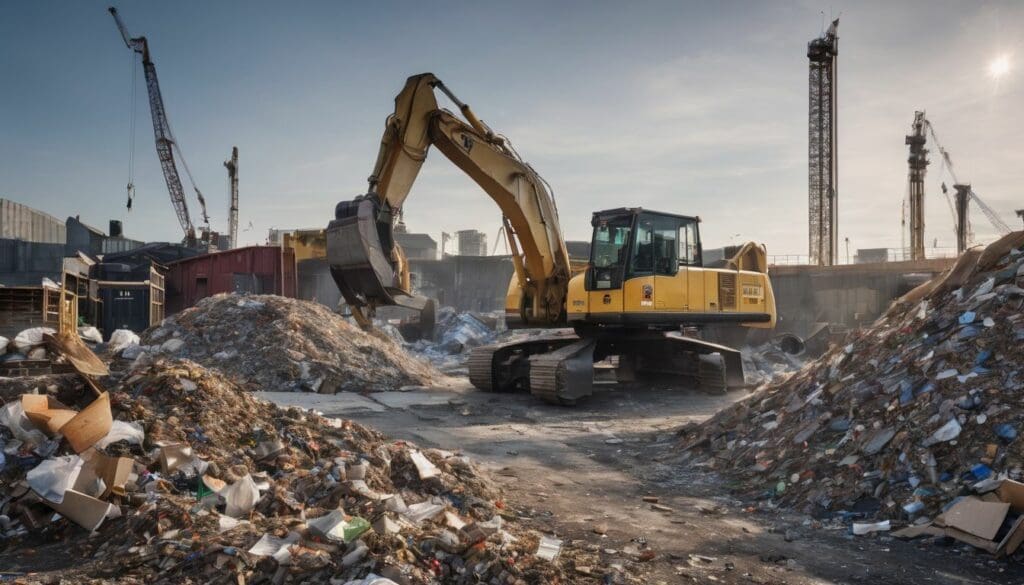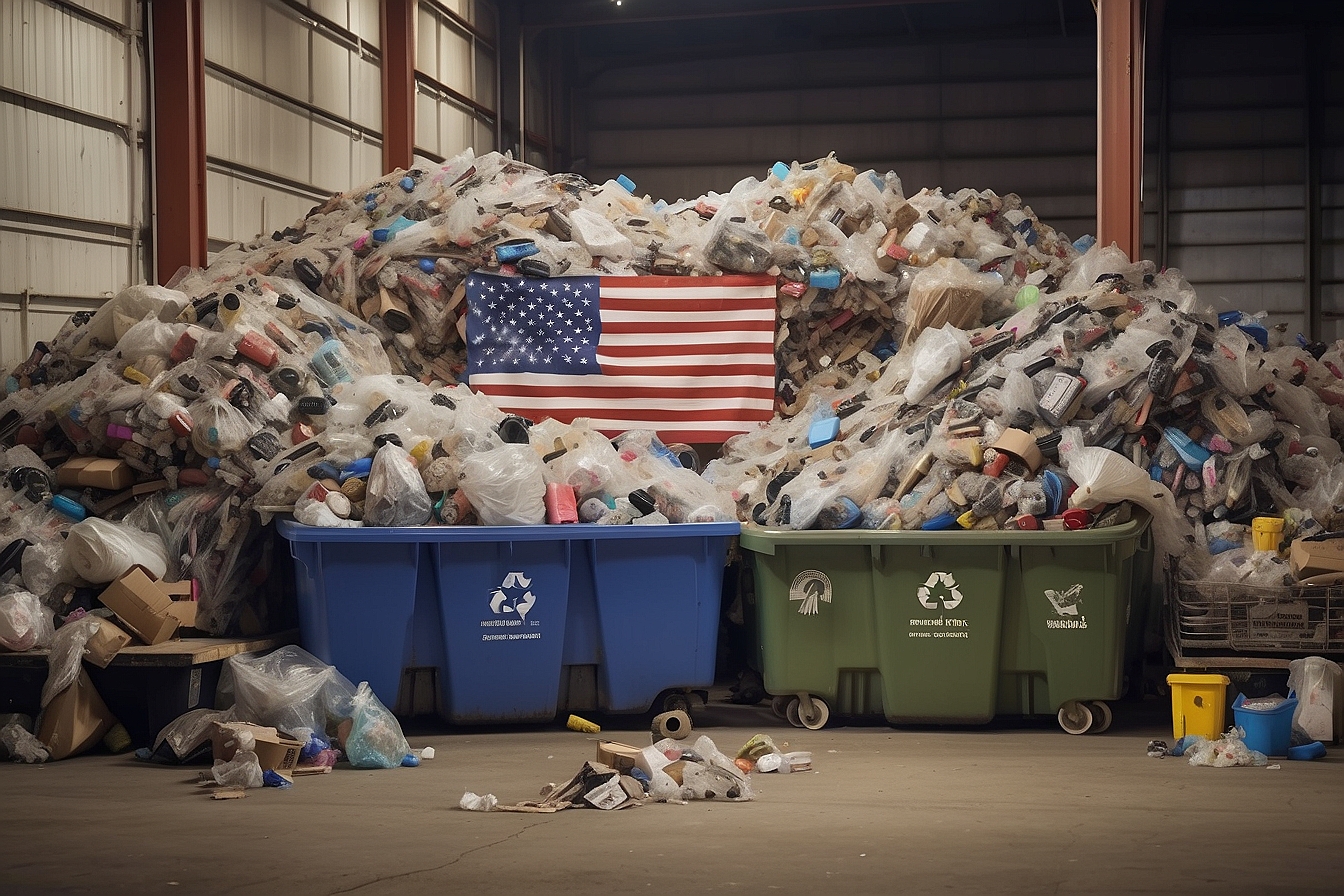Gazing upon the formidable heaps of rubble and forgotten remnants, one can’t help but be struck by the enormity of the challenge construction waste presents to our precious environment.
We stand shoulder to shoulder in this endeavour; with over 2 billion tonnes of refuse generated each year from global building ventures, we’ve donned our thinking caps and are committed to unearthing sustainable pathways.
Allow us to share some wisdom on how best to diminish, repurpose, and recycle these architectural afterthoughts into robust foundations for a verdant tomorrow. Together, let’s champion constructing sustainably!
Key Takeaways
- Over 2 billion tonnes of construction waste are generated each year, creating a huge environmental challenge.
- Recycling programs and sustainable waste management practices can divert lots of material from landfills, reducing greenhouse gas emissions and minimising the strain on natural resources.
- Using innovative strategies like modular construction, prefabrication, BIM technology and 3D printing can cut down on-site waste substantially.
- The principles of a circular economy promote reusing materials and designing buildings for longevity to conserve resources.
- Implementing design solutions that consider end-of-life deconstruction can ensure materials are salvaged and reused, supporting sustainability in the industry.
The Impact of Construction Waste
Construction waste leads to environmental degradation and contributes to the large amounts of waste in landfills, posing a significant impact on the environment. This calls for urgent strategies to address this issue and build a sustainable future.
Environmental degradation
We witness the toll that environmental degradation takes on our planet due to construction waste. Piles of unused materials and demolition debris contribute significantly to the strain on natural resources.
They lead to habitat destruction, soil erosion, and pollution of air and water bodies. Moreover, discarded construction materials often end up in landfills, where they release greenhouse gases as they decompose.
Our responsibility extends beyond building structures; we must also protect our environment against the adverse effects of development. Sustainable practices such as reusing materials help reduce the demand for new resources and slow down resource depletion.
Initiatives like recycling programs turn what was once waste into valuable assets again, closing the loop in a circular economy that benefits both our society’s infrastructure and its surrounding ecosystems.
Large amounts of waste
Transitioning from environmental degradation, we witness the concerning issue of large amounts of waste in the construction industry. Construction projects generate immense volumes of waste, including materials such as concrete, wood, and metal, contributing to significant environmental strain.
Addressing this challenge is crucial for sustainability and reducing the impact on our planet.
Innovative approaches are vital for managing construction waste effectively. Implementing efficient recycling and waste management programs can divert a substantial portion of construction waste from landfills.
Strategies for a Sustainable Future
To build a sustainable future, implementing recycling and waste management programs is crucial. Design solutions for reducing waste and embracing circular economy principles are also necessary steps in the construction industry.
Implementing recycling and waste management programs
Implementing recycling and waste management programmes is crucial for reducing the environmental impact of construction activities. Recycling programmes involve sorting and processing materials such as wood, metal, concrete, and plastic to divert them from landfills. Waste management programmes encourage responsible disposal of construction waste through proper segregation and recycling processes to minimise environmental degradation.
- Establish a comprehensive recycling programme that includes clear guidelines for sorting and recycling various construction materials.
- Integrate waste management practices into construction processes to ensure efficient handling of materials at every stage.
- Collaborate with local recycling facilities and organisations to streamline the collection and processing of construction waste.
- Educate construction teams on the importance of sustainable waste practices, including the benefits of landfill diversion and the economic advantages of waste reduction.
- Monitor and track the progress of recycling and waste management initiatives to measure their impact on reducing environmental pollution and promoting sustainable development.
Design solutions for reducing waste
To complement recycling and waste management programmes, embracing design solutions can significantly contribute to reducing construction waste. Here are some innovative strategies for environmentally conscious individuals to adopt:
- Integrating modular construction techniques to minimise material wastage
- Using prefabricated components to reduce on-site cutting and waste generation
- Implementing Building Information Modelling (BIM) technology for efficient material usage and waste reduction
- Emphasising deconstruction rather than demolition to salvage reusable materials
- Adopting 3D printing for on – site production of building components from recycled materials
Embracing circular economy principles
Embracing circular economy principles involves rethinking the traditional “take, make, and dispose” linear approach to resource consumption. By prioritising reuse, refurbishment, remanufacturing, and recycling of materials within the construction industry, we can significantly reduce waste generation and environmental impact.
This shift towards a circular economy not only conserves finite resources but also encourages innovation in sustainable material usage and waste management systems.
Choosing renewable resources for construction projects is vital in supporting a circular economy. By using eco-friendly materials like recycled steel, reclaimed wood, or sustainable composites instead of traditional non-renewable options such as concrete or virgin timber, we contribute to environmental conservation efforts.
Conclusion
In conclusion, we can all play a vital role in reducing construction waste. Sustainable design solutions help minimise waste and promote eco-friendly construction practices. By implementing recycling and waste management programs, we can work towards a sustainable future.
Let’s embrace circular economy principles to build a greener environment for generations to come.
FAQs
1. What is construction waste management?
Construction waste management involves handling and disposing of materials from building sites in ways that reduce harm to the environment and promote sustainability.
2. How can we make construction more eco-friendly?
To make construction eco-friendly, use sustainable materials, recycle waste, and plan projects that minimise environmental impact.
3. What are sustainable materials in construction?
Sustainable materials in construction are those that have a low negative effect on the environment, like recycled content or resources harvested responsibly.
4. Why is it important to focus on reducing construction waste for a sustainable future?
Reducing construction waste helps conserve natural resources, saves energy and reduces pollution keeping our planet healthier for future generations.





